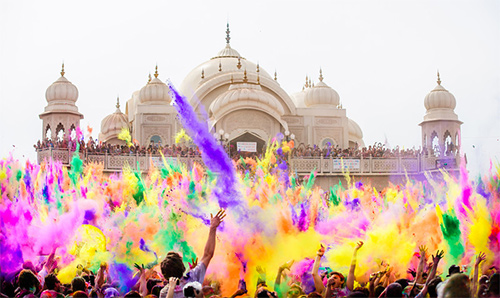
Every Indian has distinct childhood memories of Holi. Showers of colorful powder, getting doused by colorful water from ‘pichkaris’ and the resounding greetings of ‘Holi Hai’. Marking the end of the cold winter and welcoming the advent of vibrant spring. Indians celebrate this delightful festival of colors everywhere. Holi usually falls on the day after Purnima or full moon in early March every year. There are bursts of different hues all around as people throw ‘gulal’ with great laughter and glee. This unique festival was celebrated from pagan days to usher in good harvests and pay homage to the fertility of the land. There was also an association with legends from the Hindu Puranas, ancient histories of previous ages.
The tale surrounding the significance of Holi traces its origin to the story of the evil King Hiranyakashipu and his saintly son Prince Prahlada. The king was granted a boon that he could not be killed by man or beast, day or night. The young price was an ardent devotee of the Great Preserver, Lord Vishnu, which greatly displeased the king. King Hiranyakashipu wanted his son to worship him instead. The king attempted to kill his son several times – by trampling with elephants, by trapping him with deadly snakes and even by poisoning his food. But the king failed each time as the boy was protection by his devotion to his savior. Finally, the king placed him on the lap of his wicked sister Holika, who was said to be immune to fire. The cruel aunt of Prahalada sat amidst flames while the boy prince was seated on her lap. The boy fervently chanted Lord Vishnu’s name, who kept him safe on the pyre. Holika finally burnt to death while young Prince Prahalada emerged unscathed. This festival is celebrated as the grand Hindu festival of color – Holi. The colors are symbolic of the victory of good over evil and massive bon fires are lit the night prior to the festival. The story eventually concludes with the defeat of the evil king. It finally happens when the legendary Narhasimhan (half man half lion) devours him during twilight to save Prince Prahalada.
Another famous legend that envelops his festival is the remembrance of the colors of immortal love of Lord Krishna and his beautiful consort Radha Devi. Once young Lord Krishna complains to his Mother Yashoda about why he was so dark while Radha was fair skinned. His mother jokingly asks him to apply color on her face and see how it looks. The mischievous boy God playfully splashes colors on her and other gopis. The festival is observed with a lot of pomp and grandeur for 16 days in the city of Mathura, his birthplace and his favorite garden city of Brindavan. Even other towns like Nandgaon and Barsnar where Lord Krishna spent much of his earthly hours celebrate the festival in an elaborate fashion. Apart from the play of colors, there are colorful processions carrying idols of Radhe-Krishna, floats with lively dancers, rendition of folk songs amongst others. It is celebrated as the season of love, joy and happiness.
There is yet another legend about Lord Shiva opening his third eye and incarnating Lord Kamadeva, the God of Love to death. People offer Lord Kamadeva a mixture of mango blossoms and sandalwood paste. Adults and youngsters also enjoy ‘thandai’ – a drink infused with marijuana, to add to the atmosphere. Probably as Lord Shiva is associated with smoking marijuana, there is a connection in this drinking tradition.
Another Lord Shiva story is how he saved the children of the kingdom of Prithu from the evil ogress Dhoondhi. This also happened during the same time frame. Hence, children are known to celebrate during this season.
Holi is one of India’s oldest festivals. Many references can be noted in the Puranas and other holy scriptures. There are also many Holi playing scenes carved out on ancient temple walls such as the ruins of Hampi, the capital of the Vijayanagara kings. There are depictions of princesses and princes enjoying the magic of Holi by playing with water syringes.
In the olden days the coloring substance or ‘gulal’ was made from bright red flowers like tesu or palash (the flame of the forest) as well as saffron, indigo but today most people buy color powder from stores. In fact people start hoarding holi color packets much in advance. There is also ‘abeer’ which are made of tiny crystals of mica chips (natural color talc which is good for skin). This is added to the ‘gulal’ for shine. Huge mounds of bright hues like green, magenta, pink, yellow, blue, purple and red, can be seen everywhere on Holi day. Both children and adults alike frolic throwing colors on each other. Most children carry water guns or syringes with colorful mixes of water and color as well as small ‘tolis’ or packets of color powder during their colorful exploits around the block. People of entire neighborhoods enthusiastically participate in the fun and games. The festival is supposed to be the most fun-filled one amongst Indian festivals. It is loaded with excitement, merriment and not to mention a dash of fear of getting splashed by color. Young boys form human pyramids to break a pot of butter milk. A sport enjoyed from the days of Lord Krishna. Today, the prizes for breaking the buttermilk pot are often in lakhs.
There is song, dance, food and drink all around during this festival of mirth. The streets reverberate with echoing chants of ‘Holi Hai’ pan India. Although essentially a Hindu festival, it has become popular amongst Indians in general. Even the Indian diaspora abroad, irrespective of religion play with Holi colors on the auspicious day. So Holi, the festival of many hues remains the perfect festival that showcase the best of India, a land of many colors and shades.










